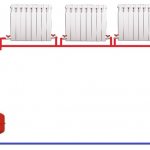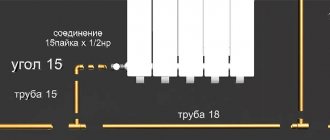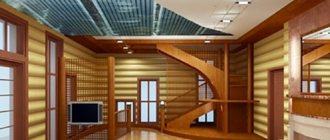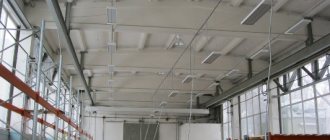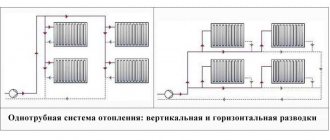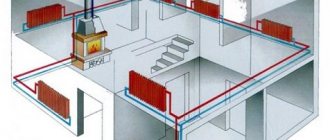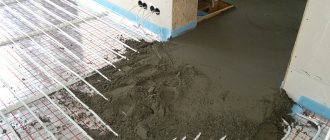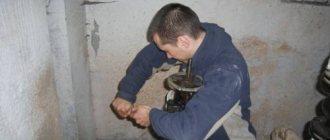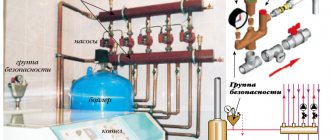Types of heating systems
Modern engineering systems, intended for heating country houses, can be:
- One-pipe. These are structurally simple and fairly common systems. Their advantages include low cost and ease of assembly. The disadvantages are uneven heating of rooms located at an unequal distance from the boiler.
- Two-pipe. Systems of this type are excellent for heating large houses and cottages. Their assembly is more expensive than installing one-pipe systems. However, heating the premises with their use can be more efficient.
Also for heating houses systems can be used:
- With natural circulation of the coolant. In this case, water moves along the highways due to pressure drops at the inlet and outlet by gravity. This happens because its density can vary quite a lot depending on the heating temperature.
- Forced circulation. Systems of this type are somewhat more complex to assemble. However, heating radiators included in their design warm up much more evenly than in one-pipe designs. In this case, the movement of the coolant along the highways occurs as a result of the operation of the circulation pump.
One-pipe heating system
Such systems are usually assembled only in one-story buildings small area. In this case, one line is included in the design, which is simultaneously both supply and return. It can be laid under the floor or directly along the wall. Radiators in such systems are installed on a bypass with a shut-off valve. Such a scheme in the future facilitates their repair or replacement, and also allows you to regulate the air temperature in different rooms. The pipes themselves are installed with a slope of at least 0.005 m per linear meter towards the water flow.
Two-pipe heating systems
Equipment of this type is, as already mentioned, very convenient to operate, but also more difficult to install. There are only two types of two-pipe systems: vertical and horizontal. The first type is usually used in single-story houses. For two- and three-story cottages, a vertical two-pipe heating system is more suitable. In this case, two risers are installed: supply and return. The contours of each floor are connected to them.
Recommendations and Tips
In conclusion, I would like to give a few recommendations that may be useful.
- The installation of piping systems should be carried out taking into account the fact that tension fittings must not be laid in the floor and walls. If this happens, then a small free space must be left to place the connections.
- Radiators should be within 70% of the window width. Panel radiators will be able to fulfill this condition. Changing the thickness of the device allows you to change its overall dimensions, and choosing the best option is not difficult
- The installation of smoke exhaust systems should not pass through rooms with a long stay of people. With an external chimney, it should be borne in mind that the distance from it to the windows of living quarters must be at least 800 mm
- When using non-freezing antifreeze liquids as a heat carrier, sectional radiators must not be installed. After a certain time, nipple connections may leak
- The use of a room thermostat with an on-timer allows you to save up to 40% of energy consumed for heating
There is still a huge number of subtleties and nuances. If you do not have experience, knowledge, working skills, then it is better to entrust the installation of heating systems to a trusted Contractor. The usual cost of work is estimated at 30-40% of the price of equipment and materials.
The best option is to conclude an Agreement with a company that will carry out all the turnkey work - develop a scheme or complete a project, complete the equipment and install it. Practice shows that the installation of turnkey heating systems helps the Customer to significantly save money. It is necessary to pay attention to the fact that the Warranty is provided for all materials and works.
Read other articles on this topic
| How to save on heating a country house | Heating a private house made of polypropylene with your own hands |
| Heating a private house with electricity | Heating system of a private house with natural circulation |
| Heating wiring for a two-story house | Private house heating project |
| How to make heating a private house | Features of heating a country house with electricity |
| About heating schemes for a private house with a gas boiler | Heating scheme for a two-story house |
| Collector heating system of a private house | Heating options for a frame house |
| Gas consumption for heating a private house - consumption calculation | Heating a private house from metal-plastic pipes |
| Heating and water supply of a country house: a description of the installation technology | The best heating for a private house |
| How to heat your home without gas | Autonomous heating of a private house |
| Heating a house with liquefied gas | Water heating in a private house |
| Heating wiring diagrams from a boiler in a private house | Installation of a heating system in a private house |
Services on this subject
| Heating design | Turnkey solid fuel heating |
| Turnkey gas heating | Turnkey heating |
| Heating in a turnkey wooden house | Turnkey water heat-insulated floor |
| Installation of a water heated floor | Heating a two-story house |
| Heating installation in a cottage | Heating a country house: options and prices |
| Heating installation | Heating installation in a private house |
| Installation of engineering systems for water supply and heating | Diesel heating of a country house |
| Turnkey autonomous heating | Air heating of a country house |
| Prices for installation of heating in a private house | Design and installation of heating systems |
| Water heating in a private house | Electric heating of a country house: options and prices |
| Heating in a townhouse | Gas heating design |
| Heating design cost | Private house heating calculator |
| Installation of a water-heated floor in a private house | Price for installation of a water-heated floor |
| Installation of a water-heated floor on a wooden floor |
Types of heating boilers
Owners who decide to assemble a heating system for their home should first of all decide on what equipment will be used for this. And first of all, of course, you need to choose a suitable boiler... There are several varieties of such units:
- Gas. This is the most common type of equipment used in most cases. Connecting such a boiler is quite expensive. However, this type of equipment is quite economical in operation.
- Electrical. Equipment of this type costs the same as its installation, it is quite cheap. However, its operation costs the owners of the house much more expensive than gas units.
- Liquid fuel. Such boilers operate on diesel fuel. The owners of the house do not have to spend too much money on the operation of such equipment. However, it is not very convenient to use. After all, the fuel needs to be stored somewhere, and it is obligatory in compliance with all the required fire safety standards.
- Solid fuel. This is the cheapest type of boilers to operate. Such equipment works on wood, coal, briquettes, etc. However, using such boilers is even more inconvenient than liquid fuel ones. Firewood or coal has to be manually loaded from time to time.
Electric boilers are usually used to heat houses only where there are no gas mains. Liquid and solid fuel - in remote areas in the absence of nearby gas pipelines and power lines.
Hot water heating schemes
They can be classified according to several parameters.
Number of spills
A single-pipe heating system (Leningrad) is suitable for apartment heating or for heating a small private house. It is the only ring filling with heating devices connected in parallel.
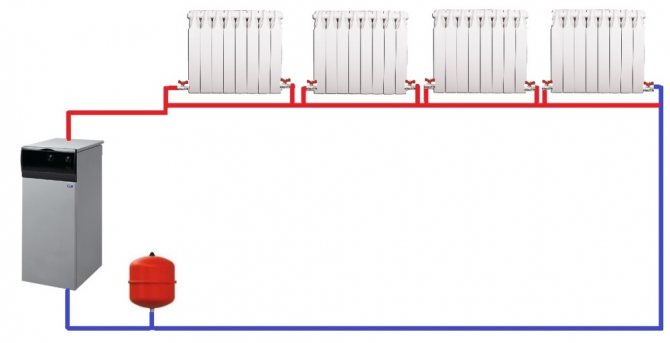
Classic Leningrad
The advantage of the Leningrad bottle is its absolute fail-safety: as long as there is at least a minimum pressure drop between the ends of the filling, the circulation in it will not stop.
A couple of shortcomings were also not without:
- The filling should form a closed ring, which imposes a number of restrictions on the layout of the heated room;
- For Leningrad women, a significant temperature difference between the batteries at the beginning and at the end of bottling is typical.
In a two-pipe system, each radiator (or group of radiators) is a bypass between two dispenses (supply and return). It is the two-pipe scheme that is used in most apartment buildings. It allows you to equalize the temperature of the batteries and has practically no restrictions on the size of the circuit.
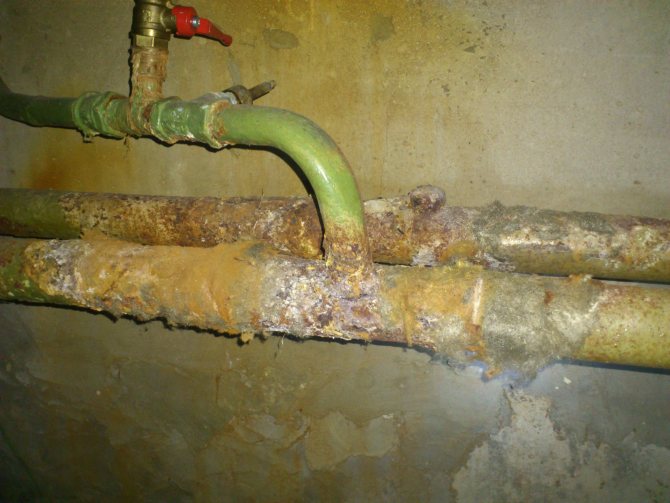

Inlet and outlet filling in the basement of an apartment building
The direction of movement of the coolant
The two-pipe system can be dead-end and associated. In the first case, when flowing from the supply to the reverse filling, the direction of movement of the coolant changes to the opposite, in the second, it remains the same.
The first circuit needs mandatory balancing - throttling of the connections of the devices closest to the heating input or boiler. Without balancing, most of the coolant volume will circulate precisely through the near radiators, while the distant ones will be noticeably colder.
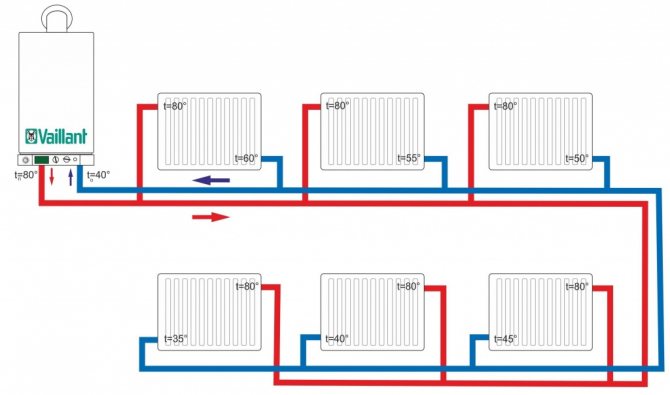

Temperature distribution of radiators in a dead-end two-pipe system
In the author's practice, there was a case when the lack of balancing of a two-pipe system led to a complete stop of circulation in distant radiators and defrosting of bottling.
A passing scheme (it is also a Tichelman loop) is several (according to the number of heating devices or their groups) parallel heating circuits of equal length and equal hydraulic resistance. The Tichelmann loop does not require balancing and ensures that all batteries are at the same temperature.
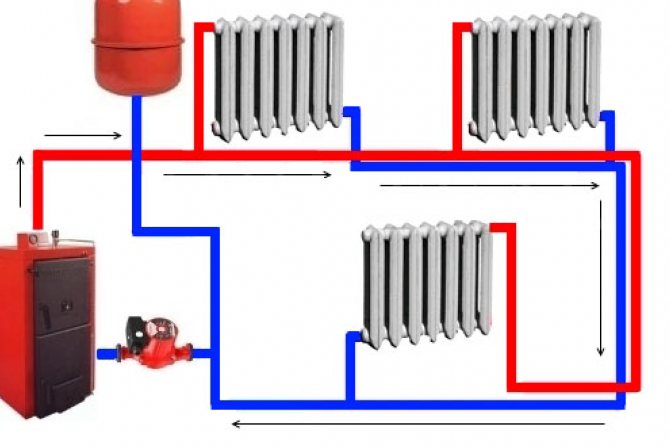

Circuit diagram with a passing movement of the coolant
Orientation
Heating wiring can be vertical (standing) and horizontal (for example, in the case of apartment heating). In most apartment buildings, the heating circuit includes both vertical and horizontal sections. A typical example is heating risers and outlets.
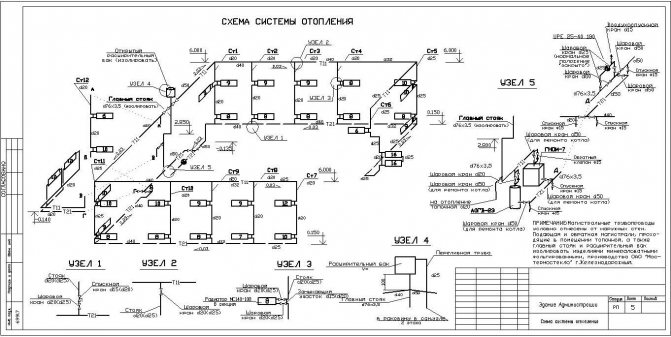

Combined (horizontal-vertical) heating distribution
Varieties of radiators
For heating systems of country houses, cast iron, aluminum or bimetallic batteries can be used. The latter variety is the most popular. Cast iron radiators are quite reliable and efficient. However, they do not look particularly aesthetically pleasing. In addition, they are too heavy, and therefore inconvenient in installation. Aluminum batteries look modern and easy to install. But they have one very serious drawback. With prolonged contact with the air dissolved in the coolant, they begin to corrode, as a result of which they quickly fail.
Bimetallic radiators are devoid of all these disadvantages. Their aluminum body is protected by steel from the inside. And therefore, its contact with the coolant does not occur. Consequently, such radiators can be considered much more reliable than aluminum ones. Bimetallic batteries weigh a little, but they look very modern and aesthetically pleasing.
Cost of work to order
Here are the average prices for the services of invited masters for the installation of heating systems.
Installation and piping of the boiler (without gas supply):
- single-circuit wall: 8 thousand rubles;
- wall 2-contour: 10 thousand rubles;
- floor-standing power up to 60 kW: 14 thousand rubles;
- floor standing up to 140 kW: 20 thousand rubles.
The cost of other work:
- Installation of an expansion tank with connection: 2 thousand rubles.
- Installation of a circulation pump in the heating system: from 3 thousand rubles.
- Assembly and installation of a heating radiator or convector: 2.5 thousand rubles.
- Assembly and installation of the built-in convector: 4 thousand rubles.
- Installation of the "warm floor" system (water): 490 rubles / sq. m.
- Installation of a thermostat on a radiator: 500 rubles.
- Pipe laying: 150 rubles / m. P.
- Laying pipes in grooves: in a brick wall - 300 rubles / r.m., in a concrete wall - 500 rubles / r.m.
- Thermal insulation of pipes: 50 rubles / r.m.
- Pressing: 4 thousand rubles.
- Chimney installation: inside the house - 1400 rubles / r.m., outside - 1800 rubles / r.m.
As you can see, from the point of view of economy, self-assembly is very, very justified.
The traditional natural circulation heating system is not so popular anymore, but it is still used in private homes. Read about how such a heating system works and how to organize it correctly on our website.
We will analyze the procedure for installing a circulation pump for heating in this topic.
Which pipes to choose
Heating mains can be assembled by hand using pipes of the following types:
- Galvanized steel. This type of pipe has such advantages as durability and ease of maintenance. Galvanized lines do not rust and do not need to be painted. The disadvantages of such pipes are the high cost and the impossibility of the device when they are used in the heating system of a large number of joints.
- Conventional steel. Such pipes are inexpensive, but not very convenient to install and fail quite quickly due to corrosion.
- Polypropylene pipes. The material of this variety is easy to install and inexpensive. The disadvantages of polypropylene include the ability to delaminate due to uneven heating of the inner and outer surfaces. Therefore, for heating systems it is allowed to use only pipes made of reinforced material of this type.
- Crosslinked polyethylene. Pipes made of this material tolerate the temperature difference outside and inside much better than polypropylene ones. However, they also have a rather serious drawback. It is impossible to mount them without using special equipment.
- Metal-plastic. Pipes of this type are most often used for the installation of heating systems. They are completely devoid of any shortcomings. Their advantages include, first of all, strength, elasticity, the ability to withstand any temperature difference and ease of installation.
For systems with natural circulation of the coolant, choose pipes as large as possible... If this figure is very large (about 8-10 cm), you may not even include radiators in the system. Their role will be taken over by the highways themselves. But, of course, such a scheme can be used only in those rooms where aesthetics are not given special importance, or in very small houses.
Requirement for heat generators and boilers
When designing a heating system for individual living quarters or apartments, it is allowed to use various models of heating boilers that are in good working order and completely ready for use.They should be regularly inspected and serviced.
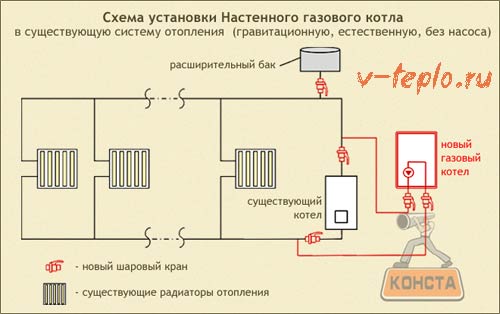

To design reliable heating, SNIP recommends using boiler systems with the following limiting performance characteristics:
- Pressure (working) - up to 1 MPa
- Coolant temperature (working) - up to 95 degrees
- Combustion chamber type - closed or open
The selected equipment should be equipped with instrumentation and automation capable of shutting down the system in the event of malfunctions (extinguished flame, disruption of the power supply, drop in pressure or temperature). It is prohibited to use boilers with open combustion chambers in apartment buildings with a height of more than 5 floors.
The installation of heating boilers in residential premises is allowed only in cases where their power does not exceed 35 kW. In other situations, it is necessary to allocate a separate room for the boiler room. The maximum power indicator of a heat generator in an individual heating system should not be more than a hundred kW.
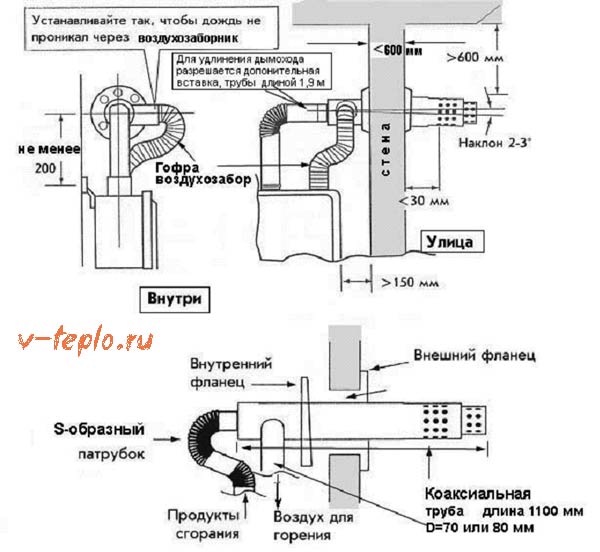

Provision should be made for fume extraction by means of a chimney system. Among the many requirements for it, it is worth noting:
- Individual sections of the chimney should be located exclusively in a horizontal or vertical position with a minimum number of bends
- It is forbidden to lay pipes in living quarters
- The chimney must be free of roughness on the inside and not have any constrictions
- Smoke must be emitted above the roof
- If the gas temperature exceeds 105 degrees, it is forbidden to use pipes made of flammable materials.
Installation of a gas heating boiler
The assembly of this type of heating system is as follows:
- The heating boiler is installed in the place designated for it (or hung on the wall, depending on the model).
- The chimney is being installed. You can also make it with your own hands - bend it out of tin or use old drain pipes. You can also purchase a ready-made version of the chimney in a specialized store.
- The boiler is connected to the gas main. It is forbidden to do this work independently according to the standards. The owners of the house will have to call specialists.
Heating types
In order to produce heating with your own hands in your monastery, you first need to choose the type of heating. To heat a private house, the type of water gas heating is most often used. This heating method includes reliability, efficiency and comfort. It is also worth paying special attention to the quality of the equipment and the structure of the system.
Systems are divided into two types:
- natural circulation - independent movement of water through pipes;
- forced circulation - implies the installation of a pump.
Both systems are complex in arrangement, but it is quite possible to carry out such an installation of the heating system with your own hands. You should choose the type based on your personal preferences, as well as focusing on the general characteristics of the house, apartment.
When making heating with your own hands in a house, you need to consider each type of heating to create a complete picture. For example, a do-it-yourself natural circulation heating system is a worthy design, which is independent of electricity. This allows the circuit to be applied in areas with a private blackout. This type of heating involves placing pipes diagonally. The location of the boiler in this case will be in the lowest zone of the house.
Forced circulation implies the presence of a pump that creates a circulating movement. This allows water to be pumped through all radiators. Also, the advantage of this type of heating will be the presence of heating equipment, which allows you to evenly heat all rooms and the farthest boilers. The circuit also allows you to economically consume gas, and interruptions in the electricity system will affect only the pump, and not the entire system.
Installation of pipes and radiators
After the boiler is installed, you can start hanging radiators... They are usually fixed under the windows. At the same time, they try to make sure that the distance from them to the floor is at least 7 cm, to the windowsill - 8 cm. There should be at least 3 cm of free space between the wall and the radiator. Fix the radiators to the wall with brackets.
Do-it-yourself piping should be done taking into account the chosen method of connecting the batteries. When installing radiators in country houses, either their diagonal connection or the bottom one is most often used. In the first case, the return pipe is connected to the lower branch pipe of the battery, and the supply pipe is connected to the upper one from the opposite side. In the second, both pipes are connected from below. The actual insertion operation itself produced according to the instructionsattached to the selected type of radiator. A Mayevsky crane or some other similar device is mandatory installed on each battery.
Self-assembly
Considering the question of how to make heating with your own hands, you can often get yourself intimidated in certain matters. This is an absolutely normal reaction to independent work, because mistakes in this matter can be very expensive for the owner of the house. Preparation of calculations and selection of equipment often become the most difficult stages in preparing for independent heating, rather than connecting equipment and the process of laying a line.
Since it will be more difficult to make heating in the house yourself, then it is worth dividing the work process into stages:
- determination of all the capabilities of the building, structural features, family needs, calculations and selection of the type and design of equipment;
- creation of a project, estimate and technical reference;
- installation of a heating boiler, water heater, expansion tank, circulation pump, heating radiators, generalization of heating equipment and the creation of a single circuit for the entire heating system;
- work and adjustments at system startup.
The last point is no less difficult in all the lists of planned works. Finishing the design with your own hands, the heating system can be checked by experts in this matter, just like developing a detailed plan for conducting, if difficulties arise at this stage. In any case, the choice of how the work will be carried out remains with the owner of the house.
The success of the installation heating work directly depends on the knowledge of the prospective employee.
You can install the heating system of a private house yourself, understanding the operating systems of the entire heating process, as well as understanding the interaction of all elements with each other. You can learn the editing processes yourself by watching training videos. This is a fairly economical method of study, clearly showing how the repair should look like.
How to include a circulation pump in the circuit
This structural element can be installed directly at the stage of assembling the system or cut into an existing structure with a natural flow of water. Recently, pumps have appeared on the market, which can be installed both on the return and on the supply pipe. However, they are quite expensive. Therefore, most of the owners of country houses prefer acquire less hardy models old model. Since the latter do not tolerate elevated temperatures too well, they are installed strictly on a return pipe on a bypass with three taps. In this case, in front of the pump itself, a filter for cleaning the coolant is necessarily mounted.
